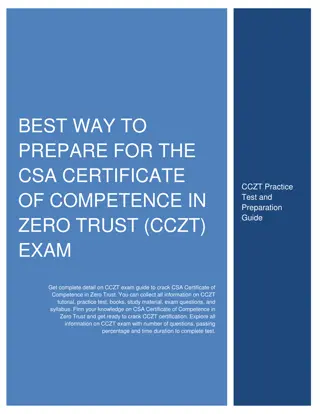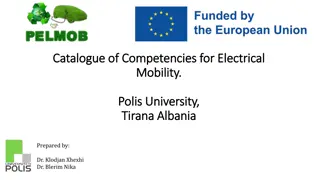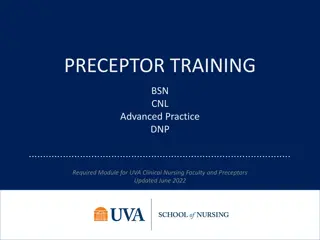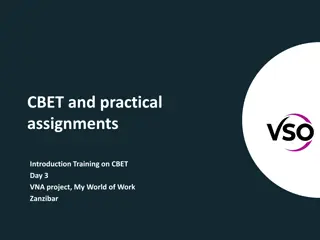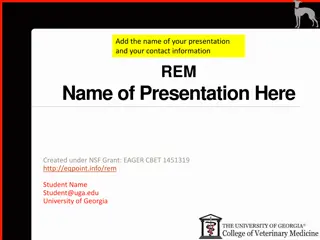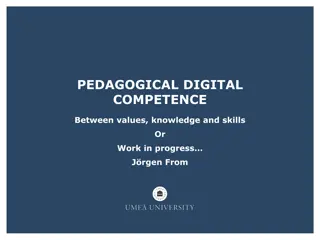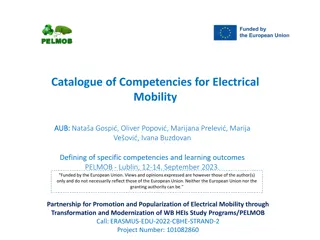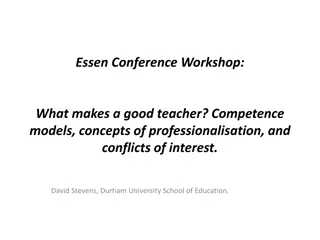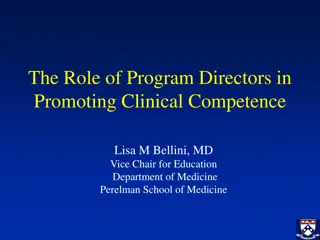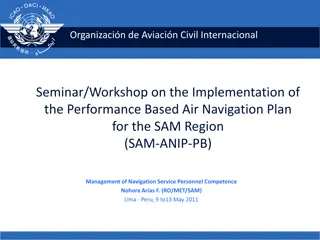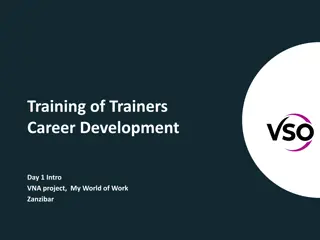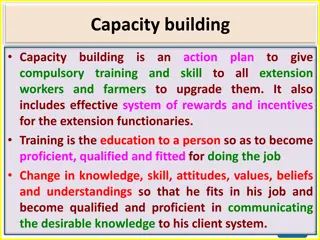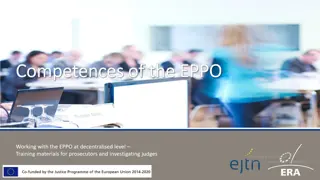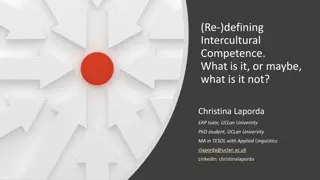Introduction to Competence-Based Education and Training (CBET) in VNA Project
Delve into the world of Competence-Based Education and Training (CBET) through an interactive training session as part of the Vijana Na Ajira project in Zanzibar. Explore the shift towards CBET, practical assignments, and collaborative learning approaches while understanding the implications within vocational training institutions. Engage in discussions, introspections, and real-world applications to enhance your understanding of CBET and its transformative potential.
Download Presentation

Please find below an Image/Link to download the presentation.
The content on the website is provided AS IS for your information and personal use only. It may not be sold, licensed, or shared on other websites without obtaining consent from the author. Download presentation by click this link. If you encounter any issues during the download, it is possible that the publisher has removed the file from their server.
E N D
Presentation Transcript
The concept of CBET Introduction Training on CBET Day 1 VNA project, My World of Work Zanzibar
WELCOME AND INTRODUCTION Brief introduction on Vijana Na Ajira project; Who is who and expectations; Objectives Introduction Training on CBET; Approach; The concept of CBET and the paradigm shift; CBL in daily practice and the CBET tree; Scan of your institution; Your practical assignment design and deliver an introduction training on CBET for a group of teachers of vocational training.
WHO IS WHO AND EXPECTATIONS Write your name, institution and area of specialization on a card; Write down in a few words what you expect to learn in this Introduction Training on CBET? Introduce yourself and your expectations briefly in the group.
OBJECTIVES Understanding of the concept of CBET; Awareness of the paradigm shift towards CBET illustrated in 5 topics; Identification of the implications of the shift: scan your institution and make the major challenges visible; Explanation of the practical assignment that each of you is going to make during this training: what, how, planning?
WORKING HOURS 09.00 10.45 : Welcome and Concept of CBET 10.45 11.00 : Break 11.00 12.50 : Scan of your institution and major challenges 12.50 14.00 : Prayers and lunch 14.30 15.45 : Practical assignment 15.45 16.00 : Reflection and looking forward
APPROACH How do we work? Learning from each other; Learning in cooperation; Active contribution of all of you; Shared responsibility for the result; Learning by reflection; Learning by doing. Golden rules Discuss with your neighbour what you like about this approach and what golden rules you yourself want to set.
THE CONCEPT OF CBET CBET: Competence Based Education and Training Why, what and how?
FAQ AND ANSWERS: THE SHIFT TOWARDS CBET Write down a question you would like to ask your colleague about this topic; Walk around, meet a colleague, put your question and listen to his or her answer; Next, your colleague asks you a question and you give an answer; You have 3 minutes for the two of you, then you move on to another colleague. Plenary: What was new or interesting for you?
WHAT IS CBET? CBET = Competence Based Education and Training CBET is a learning and teaching approach that enables learners to: Acquire competences that are needed and relevant for their future profession; Perform in their job according to professional and occupational standards. CBL = Competence Based Learning
WHAT IS A COMPETENCE? Integration of knowledge, skills and attitude Knowledge Skills Competences Attitude
WHY COMPETENCE BASED EDUCATION AND TRAINING? Competence Based Education and Training Changes in the profession/labour market New views on learning and teaching
SHIFT HAPPENS Let us have a look what is going on: https://www.youtube.com/watch?v=FdTOFkhaplo https://www.youtube.com/watch?v=wMB77eJPYs8 https://www.youtube.com/watch?v=uqZiIO0YI7Y
WHAT DOES A COMPETENT GRADUATE OR EMPLOYEE LOOK LIKE? Make in pairs a list of characteristics of a competent graduate or employee ; Compare the outcomes in your group; Compile the main characteristics into one list! Compare your list with the next slides.
THE COMPETENT' PROFESSIONAL. Takes initiative; Can improvise and comes to innovative solutions; Takes responsibilities; Is aware of the necessity to improve the quality of his/her work; Is prepared to develop himself and keep his/her knowledge and skills up-to-date.
A COMPETENT PERSON Knows and understands why = Cognitive competences Can act/do = Strategic competences Can react/interact = Social emotional competences
HOW TO ACQUIRE COMPETENCES? Competences cannot be transmitted by an expert; Competences have to be developed by the learner him/herself! The expert facilitates the learner to learn (= how to become competent).
NEW VIEWS ON LEARNING ARE NECESSARY Lack of effectiveness of knowledge-based technical training; too much emphasis on transmission . Development of new theories on learning: Learner centred/learning how to learn; Shared control; Flexibility/tailor-made; What you have learned, you must be able to show; Learning by reflection on action; Cooperative learning.
COMPETENCE-BASED LEARNING IS AN.... Active; Constructive; Integrated; Work-related; process of development and improvement by the learner, that has to be facilitated by the teacher.
Conclusions? Make a slogan in your subgroup; Write down in a few words what CBET: why, what and how stands for; Put them on a flipchart and put it on the wall.
SHIFT FROM KBL TO CBL What are the features of CBL? In the left column of the table (hand-out 1.4) are listed some features used in the direct or instructional mode of teaching (KBL); Write down individually the features of CBL in the right column: What does the shift imply?; Share your answers in the subgroup and make one list.
SHIFT FROM KBL TO CBL (CONT.) Compare - in your subgroup - your answers with the table that you can find in the hand-out 1.5; Are there similarities between this list and your list? Are there differences?; Make adjustments -if needed- in your own table; In a plenary session we check if we have understood well what the shift implies.
PRINCIPLES OF CBET From what we have discussed thus far about the shift from KBL to CBL, what do you think the basic principles of CBL are? Write down in your logbook your answers on the first two questions.
CBL IN DAILY PRACTICE The shift towards CBL, Competence Based Learning Current situation in Institutions of Vocational Training
THE CBET TREE Discuss with your neighbour the different elements that together shape CBET; In which elements are you involved?; Can you identify other persons -besides teachers- who have a task to make the CBET tree grow?; Do you work together ? Explain how?
TOPICS ILLUSTRATING THE CHANGE TOWARDS CBL A. B. C. D. E. Concept and general principles; Design of learning activities; Facilitation: teaching and learning strategies; Guidance; Assessment. What is the main shift in each of these five topics?
SCAN YOUR INSTITUTION Read carefully the statements in the paper From Knowledge-Based Learning (KBL) to Competence-Based Learning (CBL) , hand-out 1.6; Make sure that you understand the shift from KBL to CBL regarding the topics A, B, C, D and E. Discuss the shifts with your neighbour; After that, score individually your current situation in your own vocational training institution (see the scoring instructions on the hand-out 1.7).
PRIORITIES OF CHANGE: INDIVIDUAL What do you want to apply in your own lessons about CBET? Look at your scoring at the scan. Choose individually three subjects you want to apply in a more CBET way; Share those points within your subgroup and come up with ideas how you will practice those points; Make a concrete plan in your logbook what and how you will apply: this weeks, during training and afterwards.
PRIORITIES OF CHANGE: AS A GROUP Read hand-out 1.8 Priorities in the shift towards CBET; Follow the steps to prioritize the subjects you prefer to develop in your institution. Give them your 7 points; On the wall you can put your stickers/your points, together with the colleagues of the same institution; Share those points with your colleagues and come up with ideas how you will develop those subjects in the policy of your institution; Make a concrete action plan in your logbook what and how you will work on the development and implementation of CBET in your institution. Put your work as a group on a flipchart as well.
PRESENTING ACTION PLAN Present your individual or organisational plan briefly; Together we will give feedback whether the goals and the action planning are: Specific Measurable Attainable Relevant Time bound Update your goal and plan, so you can work on it.
PRACTICAL ASSIGNMENT FOR TRAINERS Readthe practical assignment 1.10 you are going to carry out in your own institution; Find a colleague with whom you want to develop and deliver an introduction training on CBET in your own institution; Make together a plan how you will carry out this practical assignment; You can use the various hand-outs and PowerPoint presentations, available in this manual.
Presentation of plans practical assignment Discuss your plan with other participants; Give each other feedback; Adjust your own plan when you get some good ideas from others;
Reflection and looking forward Give a compliment about this day and formulate a wish for next day. ASANTE SANA
The concept of CBET Introduction Training on CBET Day 1 VNA project, My World of Work Zanzibar










